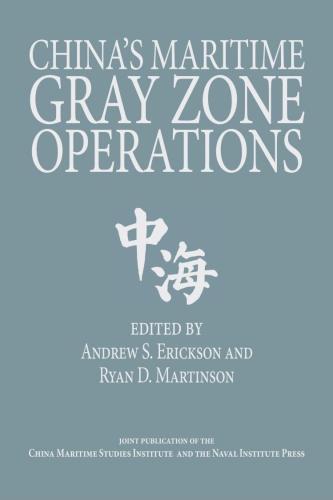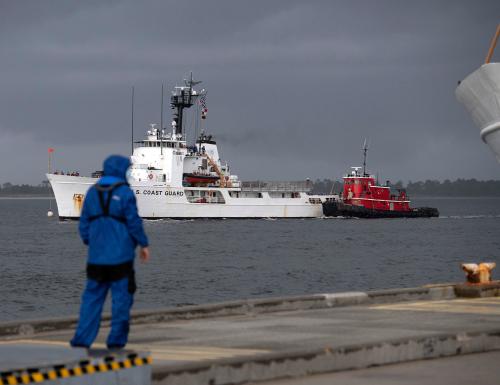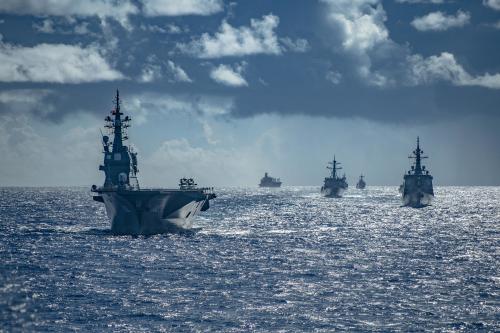The 2017 National Security Strategy and 2018 National Defense Strategy laid down a marker in arguing that U.S. agencies should shift their focus toward great power competition, specifically with respect to China and Russia. Departments and agencies have done an admirable job in beginning to make needed adjustments to address this mandate.
Yet in some cases, it is unclear which agency is best equipped to address the multi-layered challenges posed by Beijing, which often cross bureaucratic boundaries and the civilian-military divide. This is particularly true in the maritime domain, where the U.S. Navy is not always best positioned to deal with some of China’s worrisome actions, including excessive maritime claims, island-building escapades, aggressive illegal fishing, and general disregard for the maritime rules-based order. The U.S. Coast Guard is, however, uniquely positioned to address many of these problems. To do so, the Coast Guard will need to be resourced and postured to play a larger role in deterring maritime competition.
A broad mandate
Unlike the Army, Navy, Marine Corps, Air Force, and Space Force — which each have a single-mission focus — the Coast Guard has a sweeping mission set that includes defense readiness as well as maritime law enforcement, security, and governance operations. More Swiss-Army knife than Ka-Bar, what the Coast Guard lacks in “lethality” it more than compensates for in multi-mission flexibility. This makes the Coast Guard a critical tool of national power. The Coast Guard’s broad suite of operational authorities and decades of experience in working with partner nations make it perfectly positioned to slot quite neatly into an important space between diplomacy, largely led by the U.S. Department of State, and lethality, which is the clear purview of the Department of Defense (DoD) services and their supported regional combatant commanders.
And it is precisely this space that can give the United States an important edge in countering Chinese military aspirations, especially in the Pacific region. Deterring Chinese coercion of U.S. partners, and checking its gray-zone tactics, is not simply about allied reassurance. Competing in the gray zone is also essential to push back on provocative Chinese behavior quickly and forcefully, before it escalates. This will require a persistent U.S. maritime presence, not only to deter coercion, but also to train partner nations on maritime security and sovereignty protection operations, as well as participate in joint defense and security exercises. Many of these Coast Guard-like operations — which comprise the vast majority of the competition continuum short of the use of armed force — are activities for which the DoD is neither particularly well equipped, nor particularly interested in doing. This will be increasingly true in a more budget-constrained environment, because these day-to-day activities pull resources, may diminish readiness, and can distract from DoD’s core mission: preparing to, and if necessary, delivering lethal force to convincingly respond to military aggression.
Alternatively, the Coast Guard is not focused on delivering lethality. Instead, Coast Guard forces are focused on core competencies that include sovereignty enforcement, specifically with respect to exclusive economic zones; maritime law enforcement, including the interdiction of contraband; and as necessary, a defense-oriented maritime security posture. It is these very competencies that our allies in the Pacific are so interested in acquiring, because they are the very skills necessary to more effectively counter the vast majority of China’s aggressive, gray-zone regional maritime activities.
Show me the money
The real challenge, however, is the same one the Coast Guard always faces: money, money, money. How can the Coast Guard step up to help meet the challenges of a great power competition mandate when confronted with competing demands for Coast Guard services the world over, including importantly here at home in the United States?
The Coast Guard’s organic budget is relatively small, about $12 billion annually for the last several years. It does, however, often receive some reimbursable funding from the DoD along with small apportionments of Overseas Contingency Operations (OCO) funding. This OCO funding flows primarily to the Middle East to support the Coast Guard’s Patrol Forces Southwest Asia task group in the United States Central Command (CENTCOM) area of operations. This $12 billion budget, which flows through the Homeland Security Appropriations Committees in Congress and not the Defense Appropriations Committees, funds a staggeringly diverse set of Coast Guard operations and requirements: 11 statutory missions, Coast Guard personnel costs, military retirement pay, and shipbuilding and acquisitions. While the Coast Guard has had some long-needed success in building up its shipbuilding accounts over the last few years, it has not had similar success in obtaining enhanced funding for Coast Guard operations and maintenance, despite a requested increase of nearly $200 million identified for “defense readiness” in the president’s FY21 budget proposal. Indeed, the Coast Guard never enjoyed the budget growth that the DoD services received in the opening years of the Trump administration. As a result, it has experienced significantly diminished purchasing power as its flat budget has been eroded by inflation.
Herein lies the rub for the Coast Guard. Increasing the operational tempo of the Coast Guard’s overseas operations, specifically in the Pacific, would require resources the service simply doesn’t have. This is unlikely to change for two reasons. First, the Coast Guard is housed within a cabinet department — the Department of Homeland Security (DHS) — that is by definition focused on homeland threats rather than overseas missions. Second, the DoD has little incentive to see its own operations and maintenance funding diverted toward overseas Coast Guard missions it views as tangential to the department’s core priorities. And for the Coast Guard’s part, its need to recapitalize its aged fleet, address outdated information technology capabilities, and deal with shore infrastructure requirements, will all make it hard to shift precious resources towards new operations. None of this changes the fact that there is an increasing mission gap in the Pacific, which could foreseeably grow elsewhere in the world, as China’s operational reach and ambitions expand.
Increasing the operational tempo of the Coast Guard’s overseas operations, specifically in the Pacific, would require resources the service simply doesn’t have.
Committing to the long haul
The primary solution is relatively straightforward, so much so that it’s a bit cliché. As Tom Wolfe wrote in the great “The Right Stuff,” “No bucks. No Buck Rogers.” If countering China in the Pacific is truly an important component of the United States’ great power competition posture, the Coast Guard should be funded appropriately to help DoD execute that mission. Where those funds come from — whether the defense committees, through DHS, or some other source — is less important than wide acknowledgment that these Coast Guard-type operations serve as force multipliers in addressing the needs of our regional partners and deterring further gray-zone aggression.
Simply put, for a relatively meager influx of operations and maintenance funds, at least in DoD terms (where the unit cost of a single Ford–class aircraft carrier is more than the Coast Guard’s entire annual budget), the Coast Guard could provide substantially more services in the Pacific. Enhanced funding in the range of $200-$500 million would translate to improved readiness and availability of its National Security Cutter (NSC) fleet and other Coast Guard assets capable of operating deep into the Pacific theater. Importantly, this funding might actually save money for DoD. Using the Coast Guard to conduct joint military exercises and patrols, capacity building, and international training is far cheaper than using a higher-end Navy ship to perform the same missions.
Further, the Coast Guard should consider serious discussions with the United States Indo-Pacific Command (INDOPACOM) combatant commander as to whether the expeditionary patrol forces structure the Coast Guard has employed quite effectively in the Middle East could be incorporated in the Pacific theater. The Coast Guard has already shifted some of its focus to the Pacific theater, has recently deployed new cutters to the region, and is exploring new operational concepts to facilitate extended Pacific operations. Of course, the Pacific is not the Arabian Gulf, and the tyranny of distance is a serious factor to consider. But, as compared to Navy vessels, Coast Guard cutters tend to have long legs and their crews are used to operating independently. As former Navy officer Blake Herzinger has argued, a dedicated task group of Coast Guard cutters located in theater could be a powerful tool to check Chinese action as well as model responsible maritime behavior. As a corollary, as the Coast Guard plans for its Offshore Patrol Cutter acquisition, it should consider whether it could optimize a sub-class of these vessels for these types of defense-flavored operations in the Pacific.
Finally, it may also be time for the Coast Guard to consider independent foreign basing options for the first time in recent memory, perhaps with America’s close ally and “Five Eyes” partner, Australia. A Coast Guard detachment in Australia would not only provide for an additional Pacific-centric staging area, besides existing Coast Guard locations in Hawaii and Guam, but would also assist with Coast Guard strategic icebreaking operations directed towards Antarctica, which is itself becoming more and more relevant in the era of great power competition.
A relatively small influx of additional funds, coupled with a renewed focus on contemplating how and where the Coast Guard could offer added value in managing maritime competition, could play an important role in checking China’s regional maritime aspirations and deterring future conflict. But, this will take more than dabbling. It will require a real commitment in terms of budget prioritization, creative force posturing, and interoperability. As it is with most things, the Coast Guard should strive to be Semper Paratus in making this commitment.
The views expressed are the author’s alone and do not reflect the official policy or position of the United States Coast Guard, U.S. Department of Defense, Department of Homeland Security, or the U.S. Government.











Commentary
Stuck in the middle with you: Resourcing the Coast Guard for global competition
October 16, 2020